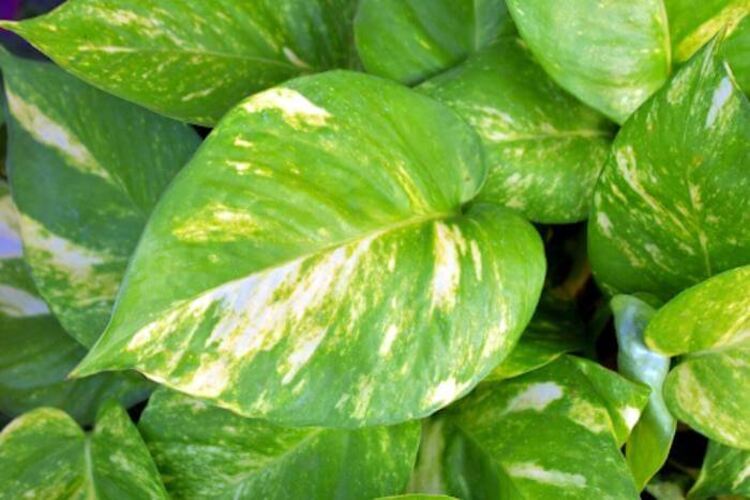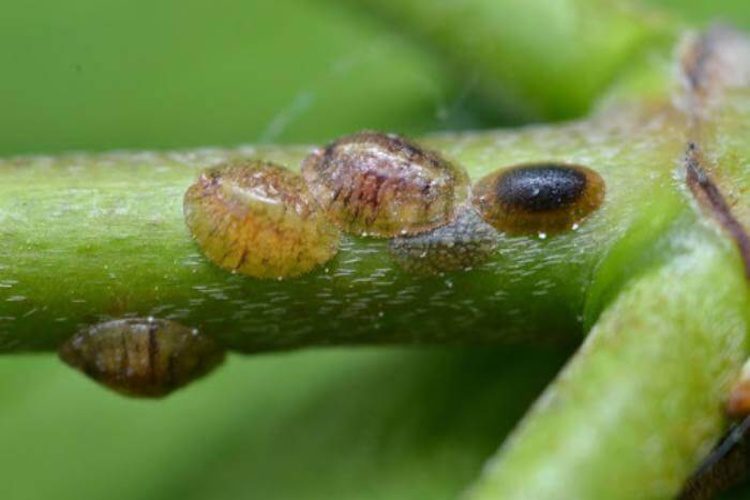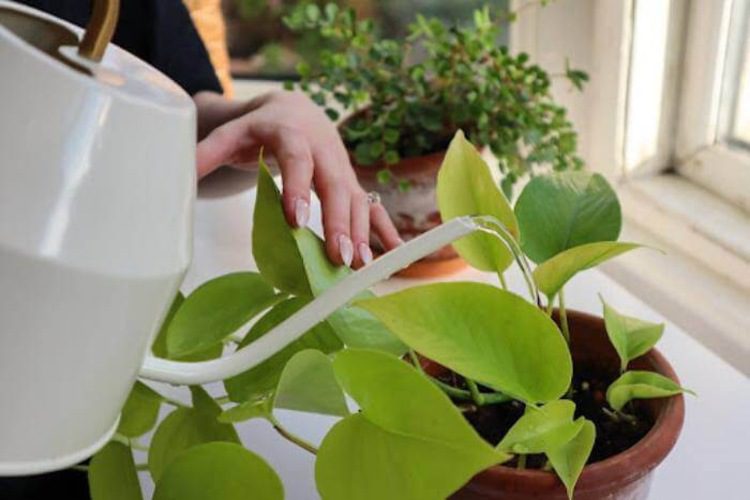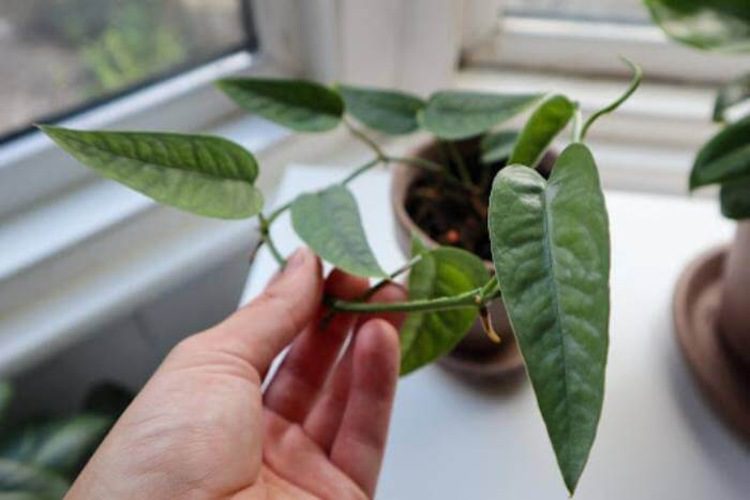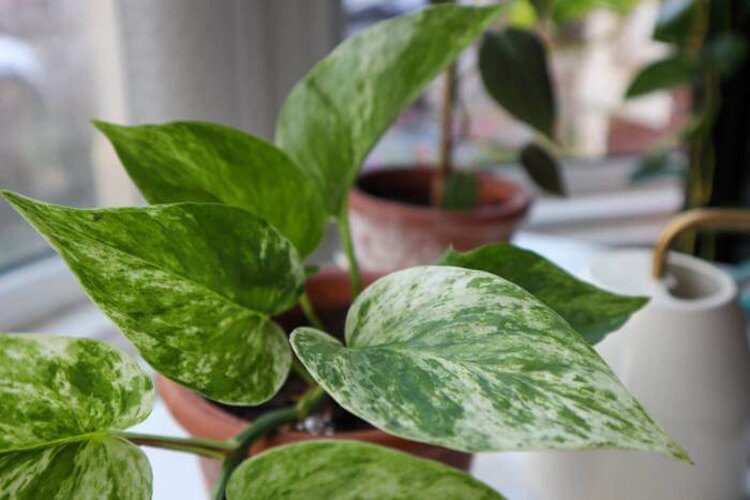Brown Spots On Pothos: 8 Reasons And Prevention

The appearance of brown spots on pothos leaves is a sign that your plant may have some issues with water, light, infestation, over-fertilization, and humidity. It also occurs because of temperature shock, small pots, and aging. So, what causes the problems of your plant, and how to fix them?
Brown Spots On Pothos Look Like
If you don’t take care of your Pothos correctly, there will be brown tips or the entire leaf will turn brown. A quick visual examination will help identify the case. The spots are tiny at first. Then, without prompt treatment, they will expand and damage the affected parts.
Sometimes, the leaves turn completely brown. The leaves with brown spots are weak. Unfortunately, you can’t recover these parts. You should cut the infected sections or the whole leaf to avoid affecting your plant.
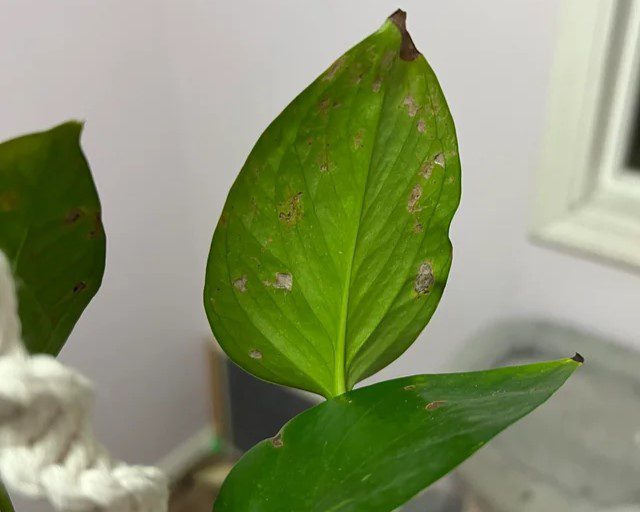
8 Reasons And How To Fix
Pothos can develop brown spots due to improper watering, illness, excessive sunlight, low humidity, too much fertilization, root rot, insects, and freezing temperatures. Luckily, there are some easy fixes you can do.
Water
Watering is essential for all plants. If you don’t do it right, there will be many problems with your Golden Pothos plant. Overwatering and underwatering are all common causes of brown spots on Pothos leaves. You need to take different steps to solve the two problems.
Overwatering
Overwatering often leads to root rot, causing brown spots and splotches on your Pothos leaves. The typical warning signals to look for include wet potting soil at all times and your Pothos’ bottom leaves going yellow to brown. The leaves on your Pothos bend, drop, or droop when they don’t feel dry. Also, your potting soil could get moldy, have squishy stem bottoms, attract bugs, etc., as a result of root rot.
What should you do?
To treat root rot, withdraw the water and check if the drainage holes of the plant pot are open. Also, give your Pothos bright indirect light, proper circulation, and an optimum temperature. Squeezing the soil may harm the roots, so avoid it even when you are trying to get rid of the excess water. Yet, poking holes with a pencil in the soil will help speed up the drying process.
Underwatering
If you forget to water your Pothos, it will start curling inward, wilt, droop, and have dry brown tips and edges. The soil will be dry too. The problem remains: your Pothos will grow very slowly, lose its leaves, and die.
What should you do?
Check if you are underwatering your plant first when you see Pothos leaves turning brown. You can touch the potting mix to tell if it’s dry. If so, water the pothos at that time. A soil moisture meter can help. The meter you use should give accurate readings and respond quickly. If the reading is 3 or lower, your Pothos needs more water.
Next, give your plant water. You should wait until the potting mix’s top one to two inches feel dry before the next watering. It’s often one week in the summer and spring and two weeks in the non-growing months. The watering frequency also depends on the environmental conditions, plant size, soil mix, pot size, and types of Pothos. There is no fixed schedule because only testing the soil can tell the best time for watering.
Light
For maximum growth, you just need to expose your Pothos to bright indirect light for four to six hours. Your plant prefers filtered light over access to the sun’s rays. Therefore, it may be obtaining too much direct sunlight if you observe your Pothos plant’s foliage turning brown or gaining brown spots, which is a symptom of sunburn.
What should you do?
If you grow your plant outside, place it in a greenhouse or under a shady tree. If grown indoors, it should stay away from grow lights or direct sunlight. You can put your Pothos near a window, but do not let the sun reach it. South-, west-, or east-facing windows all work. Blinds help when there is too much light.
Infestation
Pothos leaves turning brown can be a sign of infestation. Some pests and diseases affect your plant and damage it over time.
Pests
Sap-sucking pests, such as spider mites, mealybugs, aphids, and thrips, will cause brown spots on Pothos leaves. Some pests will also ruffle and distort the leaves. Other signs include leaf drooping and stunted growth.
What should you do?
The following are some suggestions for getting rid of those pests:
- Bring your Pothos plant outside and give it a thorough watering. Use a powerful setting to wipe the insects away, but be delicate enough not to hurt your plant.
- Use insecticidal soap, neem oil, or rubbing alcohol-dipped cotton swabs to eliminate bugs.
- Increase the humidity if spider mites are the cause. Since spider mites like dry environments, raising air moisture may stop them from becoming active.

Diseases
There are two common diseases that Pothos plants may suffer from:
Bacterial leaf spot
There are brown spots with a yellow halo. The spots will drop and leave holes in the leaves.
What should you do?
The first thing to do is to isolate the diseased plant with your hands or disinfecting equipment. Then, use a fungicide containing streptomycin or copper to treat the disease.
Fungal leaf spot
You will see round, brown spots and necrotic areas on the Pothos leaves. The spots may form patches, hastening the shedding of leaves.
What should you do?
You can use the same methods of treating the bacterial leaf spot in handling this case. Also, try to adhere to proper hygiene when touching your plant.
Over-fertilization
Over-fertilization will cause salt accumulation in the soil, burn roots, and disrupt the pH of the soil. Your plant can’t absorb water and minerals as a result of all these problems. Pothos leaves turning brown are among the signs of overfeeding. You may also notice leaf drops, crusts in the soil, and slow growth.
What should you do?
To prevent brown spots on your plant, flush the potting soil with water for about 30 minutes. Your Pothos plant requires a balanced fertilizer every four to six weeks during its growing seasons. You can also change the potting mix to achieve a balance in nutrition.
Humidity
Subtropical plants like Pothos like conditions with at least 50% humidity, which is similar to those found in their native Southeast Asia, India, Australia, and Indonesia. Your Pothos could not be receiving adequate humidity if you don’t live in a subtropical or humid area. Dry, brown patches might form as a result, most frequently on the leaf edges and tips.
What should you do?
Humidifiers may raise the surrounding air’s humidity levels. These appliances are available on the Internet and in many garden stores. Typically, humidifiers have thermostats that read the temperature. Additionally, you may set them to only work if the air begins to fall below the ambient humidity, thanks to an inbuilt hydrometer.
Another method for increasing humidity is misting. When Pothos plants suffer from low humidity, gardeners fine-mist the leaves with water. This method has an instant effect on raising the moisture level. You can also grow your Pothos in a greenhouse. A smaller space does better to keep the air at a humidity level that suits your plant’s growing requirements.
Temperature shock
Pothos leaves can turn brown under heat stress or in cold weather, like cold drafts. These temperature shocks are detrimental to your plant.
Heat stress
In severe circumstances, heat stress can seriously damage plant tissues and accelerate water loss from foliage. Curling and yellow leaves, brown tips, leaf loss, slowed development, etc. are all warning signs.
What should you do?
Move your plant to a cooler and shadier place during scorching summer days. Moreover, avoid putting it close to fireplaces, radiators, heating sources, and similar objects.
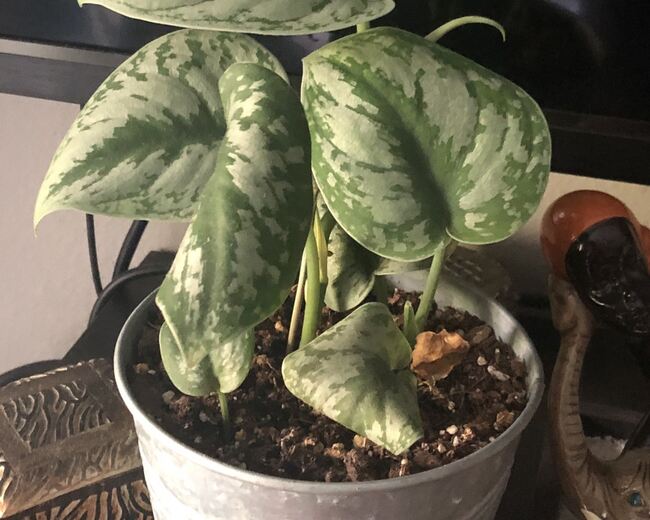
Cold drafts
Cold drafts and freezing temperatures will damage your plant cells. It may wilt and have brown spots on the Pothos leaves. In severe cases, the entire leaf will turn brown in just one night.
What should you do?
If there are often cold winters in your area, move your plant inside. It prefers a less windy, warm spot to any draughty area, such as the doorway and open window. Keep your plant away from sudden temperature fluctuations. It will also cause additional signs, including brown and yellow leaves.
Small pot
Typically, you need to change the pot of your Pothos plant several times throughout its life cycle. This species requires enough space to thrive.
So if the pot is too small, your plant won’t develop properly. You will see the roots emerging from the potholes, brown spots on the Pothos leaves, and the plant curling or dropping leaves. Sometimes, there is also a risk of root rot when water gets trapped in a small pot.
What should you do?
When it’s growing season, repot your Pothos in a bigger pot, which should be two to three inches bigger than the old one. It must be able to support the root ball and offer some extra space for development.
Aging
When the Pothos leaves age, they may first start to turn yellow, then develop brown tips, edges, or spots in addition to a curling appearance. Finally, the leaves will turn brown or dark brown.
What should you do?
This discoloration is a natural part of aging. The only thing you can do is cut the foliage when it turns yellow with a clean razor.
How To Improve Pothos Conditions?
Despite being mostly planted indoors, Pothos plants may suffer from external damage. To ensure the optimal growth of your plant, please try these tips:
Keep your Pothos clean
Always keep your plant clean to stay clear of pests and infestation. If you see any damaged sections on the plant, remove them as soon as possible. Otherwise, they will ruin the whole plant.
Prune affected leaves
If the browning has only damaged less than one-third of your Pothos plant, pruning the brown leaves off of the plant may be an excellent solution. Trim the foliage off your Pothos plant at the stem, carefully employing a sharp, clean knife or pair of pruning shears. You can also trim the brown leaves by hand, but be careful not to hurt your plant.
Drain excess water
Root rot is among the most common problems that Pothos growers encounter. Once you see your Pothos leaves turning brown, drain the excess water immediately. If not treated, the root rot will worsen and destroy your plant.
Change the soil
Soil plays a vital role in the development of your plant. So if your Pothos doesn’t seem right with the existing potting mix, especially in the case of root rot, consider changing it.
Soil with good drainage is essential for the Pothos plants. Poorly draining soil may end up suffocating the roots it should support. Either make your own soil or purchase premixed soil for your Pothos plant. Either one must be thin and have plenty of air space to promote absorption and drainage.
Repot
Your plant has to be repotted in a bigger pot if it has root rot or is rootbound. Use a new potting mix, and give the plant plenty of water after repotting. The potting soil should drain well and have drainage holes. Check for the two factors to prevent future issues with root rot.
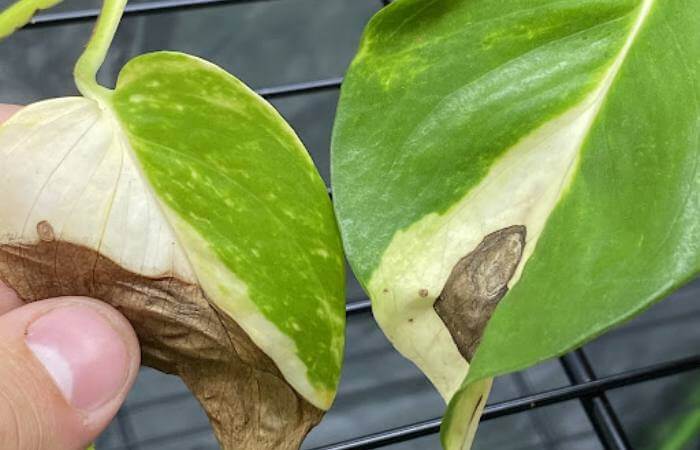
FAQs



